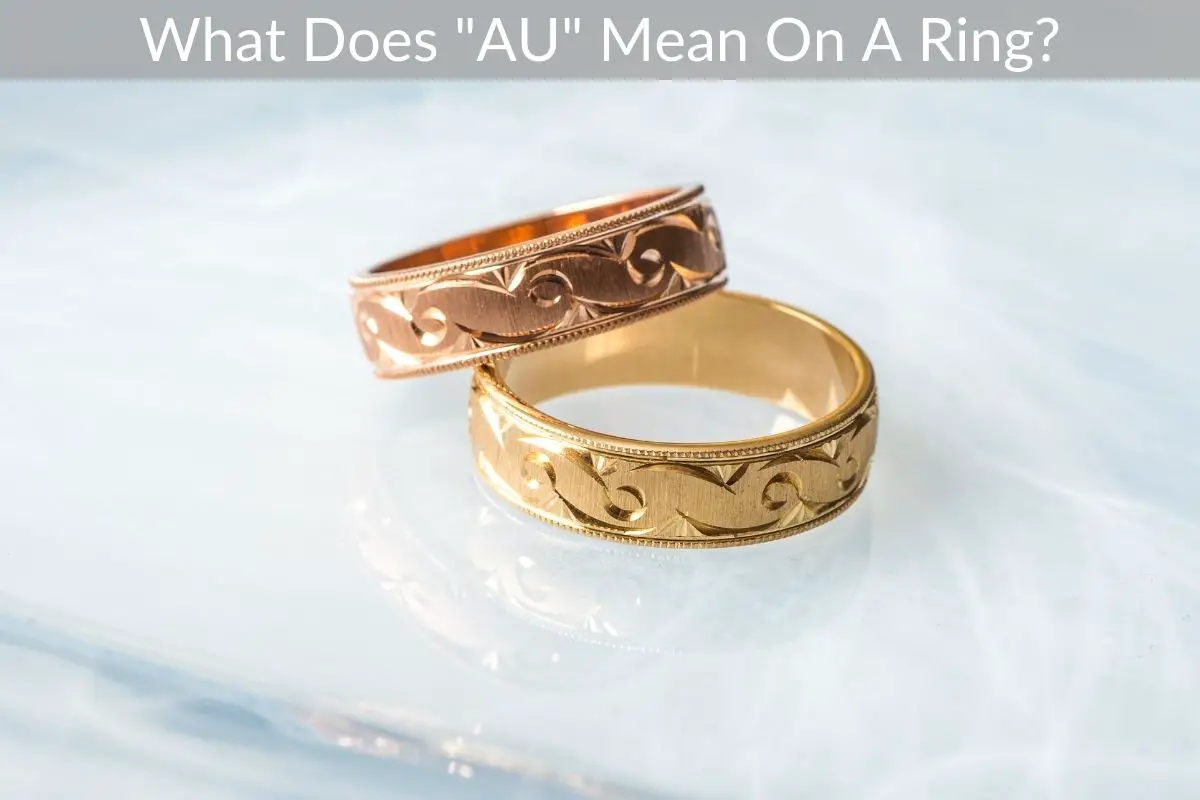Table of Contents
If you are looking to buy a ring and you see “AU” stamped on it what exactly does that mean? Should you buy a gold ring with that stamp on it?
*This post may contain affiliate links. As an Amazon Associate we earn from qualifying purchases.
An “AU” stamp on a ring or other piece of jewelry simply means the ring/jewelry is made of gold. Most rings nowadays will have a stamp with the exact type of gold used (10k, 14k, etc.) but older rings/gold might have that “AU” stamp.
When shopping for a new piece of jewelry, especially if the item is expensive or high in quality, an important part of your research should be reading any specifications. In particular, look at the fine print associated with all precious metal content.
This will tell you how much actual metal there really is inside the product.
One specification you may come across when buying gold products is “24K” which stands for 24 karat (or 22 Karat). While this term might seem self explanatory since every additional level means less pure gold, some manufacturers use other terms such as “22K”, “18K”, etc. These are also used interchangeably by various jewelers who don’t always know the difference between them.
And while these numbers can be helpful in understanding just how refined each gold grade actually is, they’re not particularly useful unless you understand where those grades originate from.
Stamp The Gold Right
There are several different organizations responsible for assigning official ratings to gold based on its color, texture and luster. The most well known of these groups is USPAPA – United States Precious Metals Association. They have been around since 1946 and were instrumental in developing standards and guidelines set forth by the international community.
AU – according to USPPA’s latest standard – refers to 1 ounce of 99% gold alloy bars weighing 400 grains. In layman’s terms, this simply means that one gram of 99%-pure gold would weigh approximately 0.4 ounces.
Another organization has taken over responsibility for setting up grading systems for gold coins. Their name is NGC – Numismatic Guaranty Corporation. You’ll find their logo on many gold coin listings online or in stores.
As far back as 1933, NGC began issuing collector pieces graded by weight rather than fineness. For example, instead of calling something “1 oz.” like USPPA uses, NGC calls it a “100 Troy Ounce”. 100 troy ounces contain 32.15 grams each, so technically speaking, the same thing.
However, because of fluctuating prices and market demand, NGC still assigns numerical values to both categories. So, if someone tells you that a certain coin contains 14k gold, ask to verify whether they meant 140 Troy ounces.
Because of these two separate but related bodies of work, people tend to confuse the meaning behind the letters “AU”. There are three main areas of confusion here. First off, the letter itself doesn’t indicate anything about the metal composition. Second, even though these symbols are sometimes interchangeable, they never stand alone without further explanation. Lastly, gold buyers often wonder why sellers bother putting “AU” on their products.
Gold Purity & Metal Price
The first misunderstanding stems from the fact that anyone familiar with currency exchange rates might think that the value of a dollar bill depends solely upon its face value. But in reality, numerous factors influence the value of money including supply and demand along with global politics. When dealing with gold coins or bullion, however, we only need to focus on two things: the purity of the metal and the current spot price.
Although it seems counterintuitive, the exact amount of gold contained within a given quantity of a precious metal isn’t necessarily a good indicator of its worth. After all, you could take 4 lbs of lead and melt it down into 12 pennies, then sell those pennies individually for $20 apiece. Each individual penny obviously wouldn’t be worth very much, but together they add up to more than four pounds! Now imagine selling the whole batch at once.
By doing so, you’d end up making nearly twice as much profit per pound of melted lead.
So, although it looks like the total mass of a substance determines its overall value, this isn’t true in general. Especially with gold, which makes the process difficult due to its extreme rarity and limited availability. Even today, gold is hard to mine and refine, so it takes a long time before enough of it comes out of the ground to meet world demands. Because of this, the supply and demand factor plays a larger role in determining how valuable gold becomes as opposed to how much of it exists.
This leads us to our next misconception regarding AU versus 99%. If you’ve read anything I’ve written thus far, chances are you already know that 99% pure gold weighs significantly less than 0.4 ounces. What you probably didn’t realize was that this distinction holds no significance whatsoever in regards to purchasing decisions.
Whether it’s coins or bars, the exact percentage of gold used in the final product doesn’t matter in regard to pricing. Only the amount of real gold matters.
Now let me explain myself better. Let’s say you own a store filled with items made entirely out of solid gold. Some of these items cost thousands of dollars, others hundreds. Whatever inventory you currently hold, you want to make sure that none of it exceeds the maximum AU limit set by USPPA.
Furthermore, you decide to keep track of each item using bar codes. Then, after finding a buyer willing to pay top dollar for whatever you happen to have left, you go ahead and enter your information onto a spreadsheet. Later on, you notice that one item costs considerably more than another despite containing roughly equal amounts of real gold.
Upon closer inspection, you discover that the cheaper item is actually comprised of 95% gold whereas the pricier version contains only 92%. Suddenly, everything you thought you knew goes right out the window.
Unless you’re extremely knowledgeable about rare earth elements, you won’t ever encounter situations like this. Why? Simple math will show you that the extra 5% added to the cheaper item adds almost half as much value as the higher priced version. Therefore, if you intend to maximize profits through resale, the best way to do so is to choose the highest quality gold possible regardless of price point.
Since 99% gold is lighter than 0.4 ounces, it generally brings in slightly lower premiums than the higher grade stuff. With that said, there aren’t too many scenarios where a consumer would benefit from going with the latter. Unless you’re planning to resell your purchase immediately, you usually won’t see the savings reflected in your pocket.
Lastly, the last major mistake we must address involves AU being confused with gold price. Although the two concepts are somewhat correlated, they differ greatly. Just because a specific commodity rises in price doesn’t automatically mean that consumers start flocking towards it en masse. Usually, when prices are high, fewer people are interested in owning them. Conversely, low prices attract more attention from potential buyers.
However, this situation changes drastically whenever governments intervene. For instance, during times of war or economic crisis, citizens become desperate for goods and services. When this occurs, demand increases dramatically and supply follows suit.
For gold specifically, this phenomenon took place during World War II. Due to shortages caused by massive military operations, people became increasingly concerned that their bank accounts weren’t safe anymore. To combat this problem, central banks started minting more coins than usual and hoarding them away under mattresses. Needless to say, the resulting inflation wasn’t pretty.
Conclusion
Hopefully now you’re able to avoid getting ripped off by unscrupulous sellers thanks to this article. Hopefully, you learned a lot about gold and precious metals in general. If nothing else, please try to remember that the gold in your possession represents a fractional ownership in the planet’s natural resources. Take care of that asset wisely and responsibly.
Do you have questions about gold or silver? Have you bought gold recently? Are you considering adding either element to your portfolio? Please share your thoughts with us in the comments below! We love hearing feedback from readers.
We hope you enjoyed this article. If you did, check out some of our recent articles about precious metals investing:

